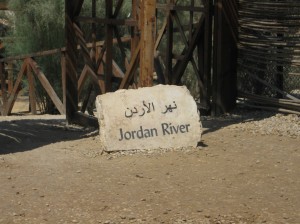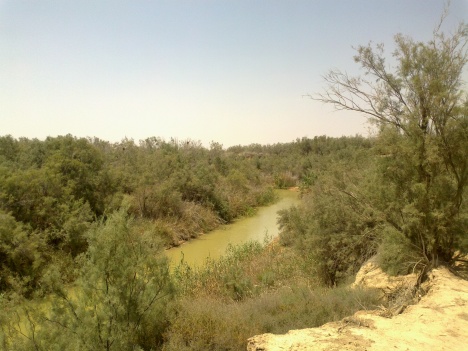
Satellite image showing the Sea of Galilee in the North (top) connected to the Dead Sea in the south by the Jordan River Valley.
The eponymous Jordan River serves as the western border of the Hashemite Kingdom of Jordan. The name has possibly descended from an ancient Aramaic word yerdon, meaning “slope,” which is also reminiscent of the Hebrew word yardon, meaning “descend.” The Arabic urdun is probably related to one or both of these words as all three languages are linguistic cousins and share ancient roots. Both monikers would be apt for this river that falls from the flanks of Mount Hermon (summit: 2,814 m) to the Dead Sea (400 m below Sea Level), making the Jordan River the lowest flowing river on Earth. This geographic morsel joined with the fact that the Jordan River Valley is the northern point of origin of the Great Rift valley would make this humble river a significant topographical feature that cannot be ignored, even if it’s historic reputation did not proceed it.
Modern-day explorers are often surprised when they finally make it to the shores of the once mighty Jordan. This river that religious texts tell us once required a miracle in order cross could now be waded in parts if it were not a highly monitored international border. Just before it finally drops into the Dead Sea the Jordan seems more of a narrow, muddy, slowly meandering creek (or “crick” as we would say back home) and not a thing of miracles. The reason for this is simple … it is the major source of fresh water in a very arid region and has been used extensively for agriculture and other purposes by the nations it runs through and between.
It is estimated that only 10% of the water that starts at the headwaters of the Jordan finally make it to the Dead Sea. Much of this water is pumped out by the nation of Israel, but Lebanon, Syria, and Jordan are said to utilize it as well. As you can imagine accurate figures about this sort of thing are hard to come by and are jaded by politics. Nonetheless it seems quite obvious that Israel takes the lion’s share of the water resources from this international boundary water. Environmentalists warn that the ecological impact of water mismanagement in the Jordan Valley may be irreversible.
 Despite these dire warnings, there is one bright spot on the banks of the Jordan – even if it is not an ecological one. Shortly after the Jordanian and Israeli governments signed a peace treaty in 1994, the Jordanians began demilitarizing a valley that was full of land mines. This lead to a Catholic monk and archeologist, Father Piccirillo exploring the area to find the Biblical “Bethany beyond-the-Jordan” where John the Baptist baptized Jesus. He made incredible archeological discoveries and under the auspices of HRH Prince Ghazi bin Muhammed the foundations of many ancient churches were uncovered. Many scholars now agree that this is the most likely site for the baptism of Jesus.
Despite these dire warnings, there is one bright spot on the banks of the Jordan – even if it is not an ecological one. Shortly after the Jordanian and Israeli governments signed a peace treaty in 1994, the Jordanians began demilitarizing a valley that was full of land mines. This lead to a Catholic monk and archeologist, Father Piccirillo exploring the area to find the Biblical “Bethany beyond-the-Jordan” where John the Baptist baptized Jesus. He made incredible archeological discoveries and under the auspices of HRH Prince Ghazi bin Muhammed the foundations of many ancient churches were uncovered. Many scholars now agree that this is the most likely site for the baptism of Jesus.
Tourists and Pilgrims can visit easily visit the site on a day-trip from Amman, even combining such a visit with a dip in the Dead Sea and taking in the view from high atop nearby Mt. Nebo where Moses gazed upon the land of promise before passing away. Information about the Bethany beyond-the-Jordan site can be found here. It is well worth the visit.

Ruins of several churches on the spot where many scholars believe is the authentic location (in Jordan) of the Baptism of Jesus
(As a side note I must say if you are planning a joint visit to both Israel and Jordan … Please save visiting the baptism site for your time in Jordan! The traditional Israeli site in the north near the Sea of Galilee has no historical significance whatsoever, and the Israeli’s have constructed their own viewing platform across from the Jordanian site. They call the place Qasr al-Yahud (castle of the Jews). Negative reactions from the Jordanian government and press to the opening of the Israeli side can be read here. The fact is that the overwhelming majority of compelling archeological discoveries are on the Jordanian side. If you want to experience this bit of history, please spend your money on the side of the river where the event is most likely to have happened. Thanks!)
Filed under: travel | Tagged: A to Z Challenge, al-Maghtas, environmental issues, geography, Jordan River, The Baptism Site, travel, المغطس | 3 Comments »



